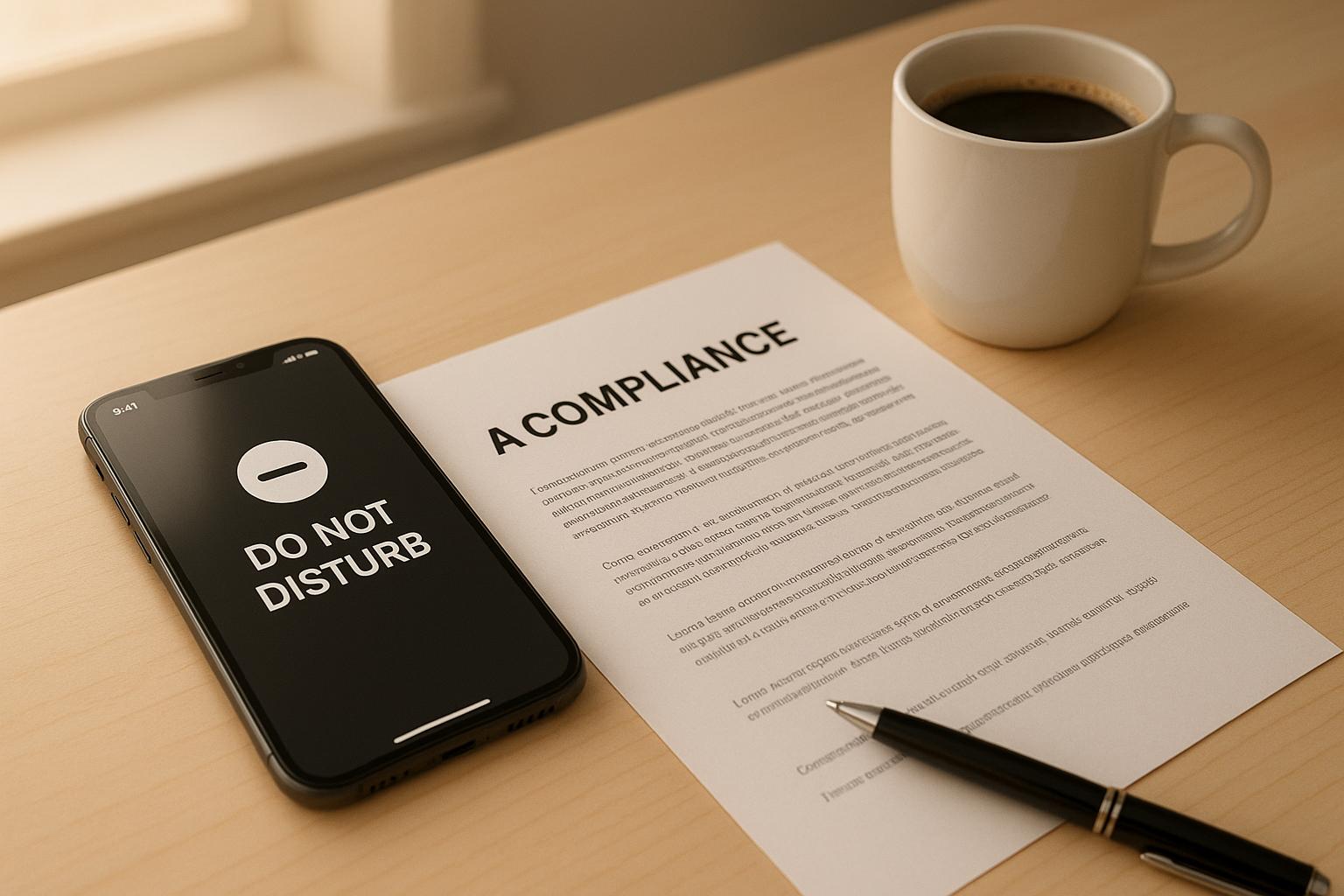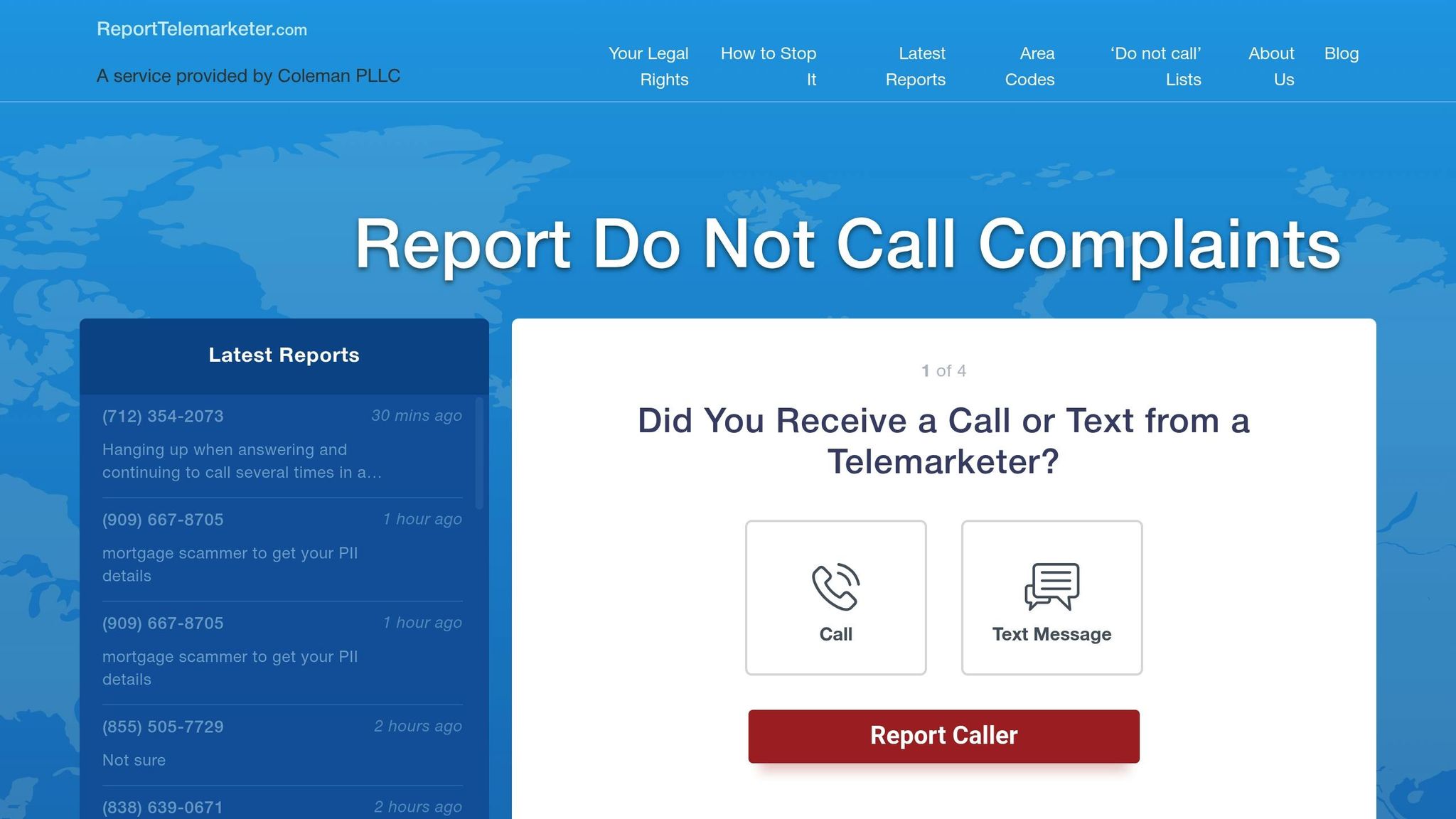
The 2025 TCPA updates are here, and they bring major changes to how businesses handle robocalls and texts. Effective April 11, 2025, these rules aim to give consumers more control while holding businesses accountable. Key highlights include:
- Easier Consent Revocation: Consumers can opt out of robocalls and texts using any reasonable method (e.g., replying "Stop", calling customer service, or sending an email).
- Faster Opt-Out Processing: Businesses must honor opt-out requests within 10 business days (6 days for delivery notifications), down from 30 days.
- Higher Penalties: Fines for violations range from $500 to $1,500 per infraction, with intentional violations reaching $10,000 per call under the TRACED Act.
- Single-Seller Consent: Consent is now limited to one company, closing the "lead generator loophole."
These changes address the rising volume of robocalls (5 billion in April 2025 alone) and require businesses to upgrade systems for compliance. Consumers benefit from stronger protections, while companies face stricter rules and enforcement.
Key takeaway: Businesses must act fast to align with these updates, while consumers now have better tools to manage unwanted communications.
How to Prepare for the April 2025 TCPA Consent Revocation Order | Convoso

New Robocall Mitigation Rules
The 2025 TCPA updates introduce significant changes to how businesses handle consumer consent and opt-out requests. These updates give consumers more control over unwanted communications while holding businesses to stricter compliance standards. The goal? To better protect consumers while ensuring companies adhere to these updated rules when using automated calling systems.
How to Revoke Consent for Robocalls and Robotexts
Under the new rules, consumers can revoke their consent to receive calls or texts through any reasonable method. This could include replying with a simple "no more texts", contacting customer service, or even sending an email. Businesses are required to honor these requests, no matter how they are communicated.
"If a called party uses any [reasonable] method to revoke consent, that consent is considered definitively revoked and the caller may not send additional robocalls and robotexts." – FCC
Importantly, companies cannot restrict consumers to a single method for revoking consent. However, there is a temporary exception in place until April 11, 2026. During this period, revoking consent for one type of message won’t necessarily stop all communications from the same sender. For example, banks can continue sending fraud alerts, payment reminders, or declined transaction notices even if a consumer opts out of other types of messages. Similarly, healthcare providers can still send appointment reminders even if a patient opts out of prescription notifications.
These streamlined rules simplify the opt-out process, making it easier and faster for consumers to take control of their communications.
10-Day Timeline for Opt-Out Requests
One of the most impactful changes is the reduction of the opt-out processing window. Businesses now have just 10 business days to honor opt-out requests, down from the previous 30-day window. For package delivery companies, the deadline is even shorter – they must process opt-out requests for delivery notifications within six business days.
This tighter timeline demands better coordination among internal teams, including sales, legal, and compliance. Tammy Glover Fowler, Compliance Officer at Contact Center Compliance, emphasizes the feasibility of this new standard:
"In the day and age we’re in now, you can really do it in 10 business days." – Tammy Glover Fowler, Contact Center Compliance
With faster opt-out processing and stricter deadlines, businesses are under pressure to improve their systems and avoid delays.
Higher Penalties for Rule Violations
The financial stakes for non-compliance have significantly increased. Violations now carry statutory damages ranging from $500 to $1,500 per infraction, with penalties tripled for willful or knowing violations. Under the TRACED Act, fines can go as high as $10,000 per call.
Recent lawsuits, such as those against Keller Williams, highlight the importance of maintaining rigorous oversight of marketing practices to avoid TCPA violations. These hefty penalties act as a powerful deterrent, underscoring the need for businesses to implement strong consent management and opt-out systems to stay compliant.
Technology Tools for Robocall Prevention
The latest TCPA rules require businesses to adopt advanced technologies to combat robocalls and safeguard consumer privacy, ensuring compliance with regulatory standards.
STIR/SHAKEN Caller Authentication
STIR/SHAKEN has become a game-changer in the fight against robocalls, specifically by tackling phone number spoofing. This system uses digital certificates to confirm the legitimacy of calling numbers. The Federal Communications Commission (FCC) has mandated that carriers implement this authentication technology to rebuild trust in caller ID information.
Here’s how it works: STIR digitally signs caller ID information, while SHAKEN provides the framework for applying STIR across voice networks. When a call is made, the originating carrier signs it with a digital certificate, and the receiving carrier verifies that signature to confirm the call’s authenticity.
Since its implementation, STIR/SHAKEN has led to a 60% reduction in unwanted robocalls since 2019. In 2024, Americans received 68 billion unwanted calls – a sharp decline compared to previous years. However, the technology’s success varies among carriers. The largest U.S. carriers sign 86% of their traffic, with over 90% achieving the highest level of verification. In contrast, smaller carriers are lagging, with fewer than 30% of their calls meeting STIR/SHAKEN standards. As the FCC explains:
"STIR/SHAKEN becomes more effective as more providers implement it."
Despite its successes, STIR/SHAKEN has limitations. It primarily works on IP networks, as older non-IP networks (like SS7) lack the capability to support the necessary data transmission. Additionally, the system verifies the originating carrier rather than directly validating caller ID information. Another challenge is that many spam calls originate from outside the U.S., where American laws have limited jurisdiction.
While caller authentication is crucial, businesses also need to focus on managing consumer permissions effectively.
Systems for Tracking Consent and Opt-Outs
Under the new TCPA rules, businesses must process opt-out requests within 10 days, requiring advanced systems to track and document consumer consent across all communication channels. These systems must manage requests from voice calls, SMS, and email, while maintaining accurate records for at least four years.
The challenge lies in going beyond basic keyword recognition. Companies must train systems to understand free-form responses, ensuring they can identify opt-out requests no matter how they’re phrased.
Aaron S. Weiss of Carlton Fields highlights the importance of a comprehensive approach:
"Businesses must implement systems that automatically track and execute opt-out requests across various platforms. This will involve updating customer relationship management systems, ensuring integration across marketing tools, and providing staff with updated training to recognize and act on all types of opt-out requests."
To meet these demands, customer relationship management systems need upgrades. These systems must integrate seamlessly with marketing tools, sales platforms, and customer service channels to ensure that an opt-out request in one channel is reflected across all others. Sales and marketing teams must collaborate closely with compliance departments to ensure requests are handled promptly. Simplifying outbound communication channels can also make it easier to track and act on opt-outs.
Automated Opt-Out Systems
Automated opt-out systems are an essential complement to robust tracking tools, helping businesses comply with the 10-day processing rule. These systems handle opt-out requests in real time, reducing the risk of noncompliance penalties and minimizing errors in managing customer preferences across multiple platforms.
However, implementing these systems comes with challenges. The upfront cost of automation is considerable, and businesses must ensure their systems can interpret a variety of opt-out messages, including informal or non-standard requests. Noncompliance can be costly, with TCPA violations resulting in fines of $500 to $1,500 per incident. Additionally, under the TRACED Act, the FCC can impose civil penalties of up to $10,000 per call for intentional violations.
To navigate these challenges, businesses should focus on refining their messaging to help consumers adjust communication preferences instead of opting out entirely. This approach not only respects consumer choices but also preserves customer relationships, ensuring compliance with the new regulations.
Impact on Consumers and Businesses
The 2025 updates to the TCPA bring major changes to robocall regulations, strengthening protections for consumers while imposing stricter compliance requirements on businesses. These updates affect millions of Americans who deal with unwanted calls and thousands of companies that rely on automated communication systems.
Stronger Consumer Protections
Consumers now have more control over how they handle unwanted calls and texts. The updated rules allow individuals to revoke their consent through any reasonable method. Previously, businesses could insist on specific keywords or channels for opting out. Now, consumers can simply send messages like "Stop" or "Cancel" to opt out, regardless of the platform.
"Under the new rules, consumers can revoke prior express consent under the TCPA in any reasonable manner that clearly expresses a desire not to receive further calls."
- Kierstan Schultz and Christina Kurow, Nixon Peabody LLP
Another major improvement closes the so-called "lead generator loophole." Consent is now restricted to a single seller, meaning consumers won’t receive calls from multiple companies just because they gave permission to one. This change ensures communications remain tied to the original interaction, reducing unwanted calls significantly.
These updates require businesses, especially call centers, to rethink their practices to align with the new consumer protections.
New Requirements for Call Centers
With the expanded opt-out options, call centers face new operational challenges. They must now accept opt-out requests through any reasonable method, regularly update their dialing lists against the National Do Not Call Registry, and maintain detailed opt-out records for at least five years. Additionally, calls are restricted to between 8:00 a.m. and 9:00 p.m. local time, and any use of nonconsensual automatic dialing is strictly prohibited.
The penalties for noncompliance are severe – violations can result in fines ranging from $500 to $1,500 per infraction, with no upper limit on total penalties. Companies that rely on consumer communications must ensure all opt-out requests are honored, which requires careful coordination among departments. Businesses are allowed to send a one-time clarification message after receiving an opt-out request, but this message cannot include any marketing or promotional content. To meet these new standards, call centers will need to invest in staff training, conduct random audits, and verify compliance at every stage.
Before and After Comparison Table
| Feature | Before 2025 TCPA Updates | After 2025 TCPA Updates |
|---|---|---|
| Consumer Opt-Out Methods | Limited to specific keywords or channels | Any reasonable method accepted |
| Consent Sharing | Lead generators could share consent across multiple companies | Consent limited to one identified seller per agreement |
| Burden of Proof | Varies by situation | Calling party must prove revocation was reasonable |
| Clarification Messages | No specific restrictions | One-time SMS allowed to confirm opt-outs, no promotional content |
Businesses must act quickly to adapt to these changes. The transition period demands a thorough review of current consent practices, updates to policies, and an examination of lead sources to ensure compliance with the new rules. These updates represent a major turning point in robocall regulation, shifting the balance of control toward consumers.
"It is critical to understand what is changing and why these changes matter. Failure to comply could result in hefty fines, legal challenges and reputational damage."
- Carlton Fields
sbb-itb-a8d93e1
How to Report Robocalls
With updates to the TCPA giving consumers more authority, reporting unwanted robocalls has become a more powerful tool. Here’s how you can take action using reliable resources.
ReportTelemarketer.com Services for Consumers

Dealing with pesky telemarketing calls or texts? ReportTelemarketer.com is here to help. This free service investigates telemarketing violations and takes legal action on behalf of consumers. From filing cease-and-desist letters to submitting formal complaints, they handle it all – recovering legal fees directly from the offending telemarketers.
What’s more, ReportTelemarketer.com increases public awareness by sharing information about reported telemarketers. This helps others recognize problematic companies, all while keeping user privacy intact. They also offer educational resources to help you understand telemarketing laws and your rights as a consumer. By streamlining the reporting process, this service works hand-in-hand with the TCPA’s new protections and technological measures.
Getting Money Back from Telemarketers
Did you know you might be entitled to compensation for telemarketing violations under the TCPA? ReportTelemarketer.com can assist in building your case for issues like Do Not Call violations, ignored opt-out requests, or unauthorized calls. They investigate, file complaints, and even pursue legal action on a contingency basis – meaning you don’t pay upfront.
To strengthen your case, keep track of key details like caller ID, messages, dates, and times. This documentation can be crucial evidence if you decide to seek compensation.
For additional support, you can also file complaints with the FCC at fcc.gov/complaints or the FTC. Be sure to save all your records. If violations persist, consulting a TCPA attorney might be your next step. Luckily, ReportTelemarketer.com provides access to specialized legal expertise as part of their free service, making it easier for consumers to tackle illegal robocalls. These steps, combined with the updated TCPA protections, empower you to hold telemarketers accountable.
Conclusion: Preparing for the New TCPA Rules
The upcoming 2025 updates to the TCPA bring a major overhaul to robocall regulations, aiming to give consumers more control while pushing businesses to adapt swiftly. Starting April 11, 2025, these new rules allow consumers to revoke consent through any reasonable method, require businesses to process opt-out requests within ten business days, and impose fines of up to $1,500 per violation. With robocall volumes on the rise, the urgency for businesses to comply has never been greater.
For businesses, staying compliant isn’t optional – it’s essential. Noncompliance risks hefty penalties and legal actions, with statutory damages ranging from $500 to $1,500 per violation. Beyond the financial impact, transparency and trust with consumers are at stake.
"Staying compliant with the TCPA is not just about avoiding fines or legal actions; it’s about building a transparent and respectful relationship with consumers." – VerticalResponse
These changes also signal the need for immediate shifts in technology and operations. Businesses must implement STIR/SHAKEN authentication, automated opt-out systems, and designate compliance officers. Real-time tracking and regular audits of consent documentation are now non-negotiable for ensuring adherence to the updated rules.
On the consumer side, tools like ReportTelemarketer.com offer a way to report violations and seek compensation. As enforcement tightens and penalties increase, these combined efforts – stricter regulations, advanced technology, and active consumer advocacy – are poised to significantly reduce illegal robocalls and give consumers greater control over their communications.
FAQs
What do the new TCPA rules mean for businesses managing robocalls and texts?
The updated TCPA rules introduce important changes that businesses must follow, particularly when it comes to obtaining clear consent from consumers before making robocalls or sending text messages. Starting April 11, 2025, companies will also need to adhere to stricter guidelines for revoking consent, ensuring consumers can easily opt out of communications they no longer wish to receive.
To meet these new requirements, businesses should focus on setting up reliable systems to record consent and streamline opt-out processes for users. On top of that, the FCC now requires businesses to adopt proactive monitoring and mitigation measures to prevent potential violations. This makes compliance an ongoing effort rather than a one-time task. Ignoring these updates could lead to legal penalties, so it’s essential for businesses to adjust their practices accordingly.
What changes have been made to how consumers can revoke consent under the updated TCPA rules?
Under the revised TCPA rules, consumers now have the ability to revoke their prior express consent for robocalls or texts in any reasonable manner – whether that’s replying directly to a message or reaching out to the caller. Businesses are required to process and honor these revocations within 10 days. Starting April 11, 2025, consumers will also have the option to send confirmatory opt-out texts to withdraw consent. These changes are designed to simplify and speed up the process for stopping unwanted communications.
How does STIR/SHAKEN technology help reduce robocalls, and what are its limitations?
How Does STIR/SHAKEN Work to Stop Robocalls?
STIR/SHAKEN is a system designed to tackle the problem of robocalls by verifying whether the caller ID information is legitimate. In simpler terms, it helps confirm if the number showing up on your phone screen is actually the number making the call. This makes it easier for people to spot genuine calls and steer clear of scams. It’s a big move toward restoring trust in phone communication.
That said, STIR/SHAKEN isn’t without its challenges. For starters, it’s built to work on IP-based networks, so older, non-IP systems can’t take full advantage of it. On top of that, its success hinges on how widely phone carriers adopt the technology. If smaller or less-resourced carriers don’t implement it, there can be gaps in its coverage. While it’s a strong step forward, it’s not a one-size-fits-all solution for eliminating robocalls entirely.